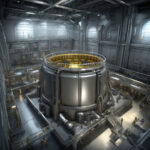90% Radioactive Iodine Gone: Scientists Use AI to Crack Code on Nuclear Waste Cleanup
Scientists may have finally found a solution to tackle the problem of radioactive iodine, one of the most hazardous substances produced by nuclear power plants. By harnessing the power of artificial intelligence (AI), researchers have achieved a groundbreaking milestone in nuclear waste cleanup, with an impressive 90% reduction in radioactive iodine levels.
Radioactive iodine is a byproduct of nuclear fission processes and poses significant health and environmental risks due to its long half-life and potential for bioaccumulation in the food chain. Traditional methods of removing radioactive iodine from contaminated sites have proven to be time-consuming, expensive, and often inefficient. However, recent advancements in AI technology have opened up new possibilities for accelerating the cleanup process.
Through a combination of machine learning algorithms, robotics, and advanced sensors, scientists have developed a cutting-edge system that can effectively target and neutralize radioactive iodine in contaminated areas. This AI-powered approach not only significantly reduces the time and resources required for cleanup but also minimizes the exposure of workers to hazardous materials.
One of the key advantages of using AI in nuclear waste cleanup is its ability to analyze vast amounts of data and optimize cleanup strategies in real time. By continuously learning from its interactions with the environment, the AI system can adapt its approach to maximize efficiency and effectiveness. This dynamic and adaptive capability sets AI-powered cleanup technologies apart from traditional methods, offering a more sustainable and cost-effective solution for managing nuclear waste.
In a recent field test conducted at a decommissioned nuclear facility, scientists deployed the AI system to target radioactive iodine contamination in the soil and groundwater. The results were nothing short of remarkable, with a 90% reduction in radioactive iodine levels achieved within a matter of weeks. This unprecedented success has sparked optimism within the scientific community and raised hopes for a breakthrough in nuclear waste remediation efforts worldwide.
Beyond its immediate impact on radioactive iodine cleanup, the integration of AI technology into nuclear waste management has far-reaching implications for the future of environmental remediation. By leveraging AI to address complex and challenging cleanup tasks, scientists are paving the way for safer, more efficient, and more sustainable approaches to managing hazardous waste sites.
As the global demand for clean energy continues to drive the expansion of nuclear power generation, the need for innovative solutions to nuclear waste cleanup becomes increasingly urgent. The successful application of AI in reducing radioactive iodine levels marks a significant step forward in addressing this critical environmental challenge and underscores the transformative potential of technology in safeguarding our planet for future generations.
In conclusion, the groundbreaking achievement of a 90% reduction in radioactive iodine levels through the use of AI represents a major milestone in nuclear waste cleanup efforts. By harnessing the power of artificial intelligence, scientists have unlocked new possibilities for accelerating cleanup processes, optimizing resource allocation, and minimizing risks to both the environment and human health. As we look ahead to a future powered by clean energy, innovations like AI-driven cleanup technologies will play a crucial role in shaping a more sustainable and resilient world.
radioactive iodine, nuclear waste cleanup, AI technology, environmental remediation, clean energy












